
Digital marketing for healthcare is unique. It shares some of the same principles as marketing for other areas, but the future patient or googler is going to do their homework. The same factors apply, but trust, speed and reputation are relied upon more.
In this guide we cover:
Tactics are fine, but what you’re going to want is a strategy. A marketing strategy is a document that can have buy-in from the executive level and be relied upon by the team eight months later. The “eight months later” part is crucial because it’s often the case that companies give up or change focus when the tasks become dull. It’s human nature to want to take on new and more exciting work. This is where we see the strategy earn its strong reputation – in keeping focus and winning because of it.
What goes into a Healthcare digital marketing strategy? The questions to ask are:
This post is meant to examine #5 on the list.
Many organizations try to win the fight with a bad website, which is a tough road. There are always workarounds to what people will deem a “bad website”, but here’s a few immediate things to look at.

Risa Wexler, head of Pfizer’s Media Lab, explains on thinkwithgoogle.com that one of Pfizer’s sites took 21 seconds to load. “No, thanks, I don’t have time for this.” And they would abandon the site, perhaps without getting the information needed to make an informed health care decision.”
A slow site doesn’t just make people abandon the site immediately. Google will also abandon it as well by dropping your ranking and not allow traffic to get to your site. They want to promote positive experiences for their users and a slow one isn’t a great experience.
Our favourite site speed test is GTmetrix, but Google’s works as well.
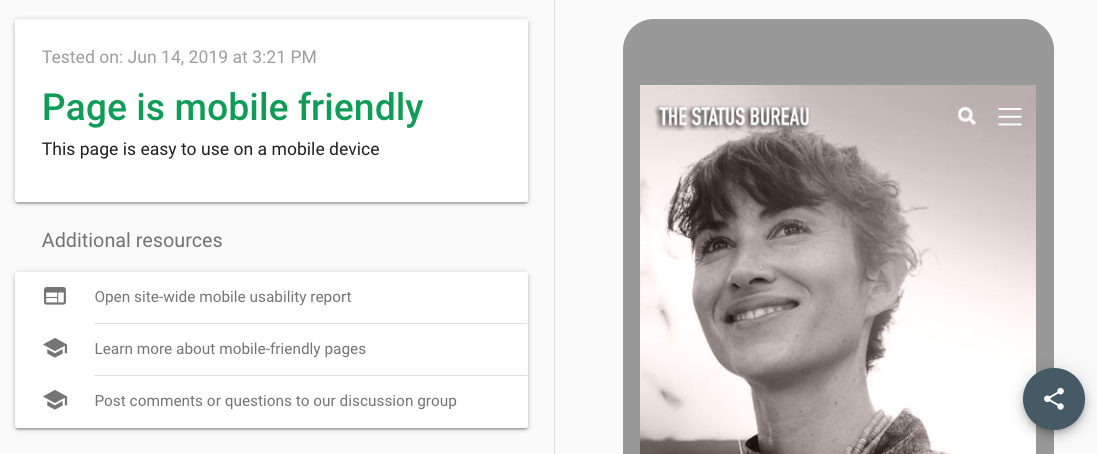
If your website has been designed only for a desktop view, you could be losing the majority of your potential audience.
You can find out how mobile friendly your website is by using Google’s Mobile-Friendly Test.
Often overlooked is the clarity of service that a healthcare provider offers. It is difficult to imagine people not understanding your offering, but they’re new to this. A Flesch–Kincaid readability test is the standard of reading and writing complexity. Readable is a fun and quick way to help understand how complex your content is.
SEO (search engine optimization) can be split into a few different categories. Local SEO, E-Commerce SEO, and International SEO are all slightly different and have unique characteristics.
Local SEO for healthcare is for hospitals, doctor’s clinics, dermatologists, nursing homes, diagnostic clinics, dental offices, orthodontics offices, and others. Anything with a physical location.
When googling “dermatologist” from my office in Vancouver, BC, I see service providers that are close to me. Proximity is the #1 factor in SEO now, so this is something organizations need to pay attention to.
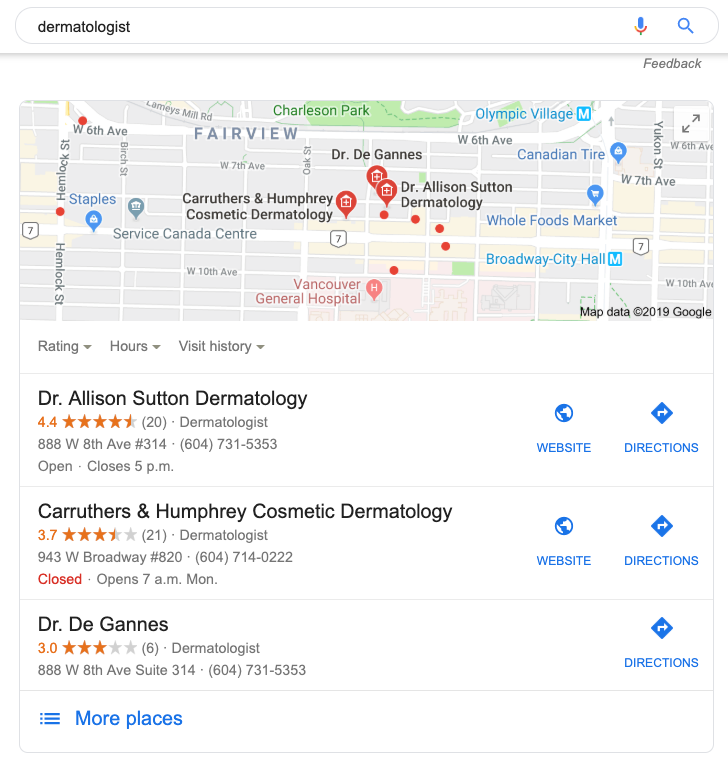
Google defines dermatologists as local businesses for good reason. Google is attempting to provide the user with the best answer to my search. The same exists for bookstores, dry cleaners and ice cream shops. This localization of search results is the most important factor in healthcare digital marketing because you’re meeting the person half way.
There’s some very convincing data to support the case for Local SEO from this Hubspot post:
Our thought at The Status Bureau is that Local SEO is the first and most important tactic in healthcare marketing.
There are many variations of searches out there on the internet. Some of them really don’t have much connection to the other. The takeaway is to ensure your targeting and stats are focused on your keywords, and they are not skewed by unrelated terms. For example, popular keywords related to “doctor” are:
Where I’ve seen this go off the rails are for traffic, impressions, and strategy. If there is a blog post about being a “good doctor” and it is relative to the user’s query, it can show up and inflate the traffic numbers. Without a deep dive into the stats and filtering out unnecessary items, the data (and strategy based on them) could be completely off.
Local SEO is for locations near the user. What if you run or service or SaaS that needs a national reach? This is obviously different from a set of Local SEO tactics.
A few things to consider in National vs. Local SEO are the location factors. Location means a great deal in Local. For National SEO, we can slightly ignore those items and reach for bigger reach strategies. Content marketing and linkbuilding are two pretty decent places to start.
For us, Content Marketing falls into SEO, but it can be categorized however people feel it should be. Content Marketing can also mean a million things. Some popular content marketing tactics are:
This content can then be distributed in a few different ways:
Choosing content marketing that works for your Healthcare organization should fit with the brand guidelines and what you’re trying to achieve. It can also be a matter of trial and error. Good marketing teams can pivot until they find the thing that works best.
Linkbuilding is the process of getting other websites to link to yours. It’s how Google understands that your website is authoritative and good enough to rank in their search engine.
Building links to any site, and especially in healthcare, is crucial. Regardless of the reputation your organization may have, if there is a low amount of high quality links headed to your website you can bet that Google won’t give it a chance.
Linkbuilding is tricky and takes a long time, but it’s worth it. You can either find a linkbuilding company that knows the ins and outs of generating them or you can grind away at this yourself. I’d suggest maybe a mix of both. For inspiration, Backlink.io always produces an exhaustive list of linkbuilding ideas.
Directories have always had a place on the internet. They predate the search engine—it was how people found things. Now, directories go hand in hand with search engines. Google uses directory information to make informed ranking decisions.
Here’s our top 5 Healthcare Directories in different categories.
Alternative Therapies:
Beauty & Cosmetic:
Counselling & Therapy:
Note: Our friends at counsellingbc.com have a perfect regional directory for Vancouver Counsellors, Psychologists and Therapists.
Chiropractors:
Dentists:
Doctors:
Nursing & Childcare:
Healthcare marketers know that trust is paramount. Directories play a very strong role in reputation management and trust building. Yelp and some others have wavering reputations, but they are a necessity online when communicating the value and safety of a healthcare provider.
If your clinic has no listing or reviews, user questions are:
If your clinic has a few negative reviews, the questions will be:
If your clinic has overwhelmingly positive reviews, the questions will be:
Reputation management via directories isn’t perfect, but it’s necessary to instil confidence in a future patient.
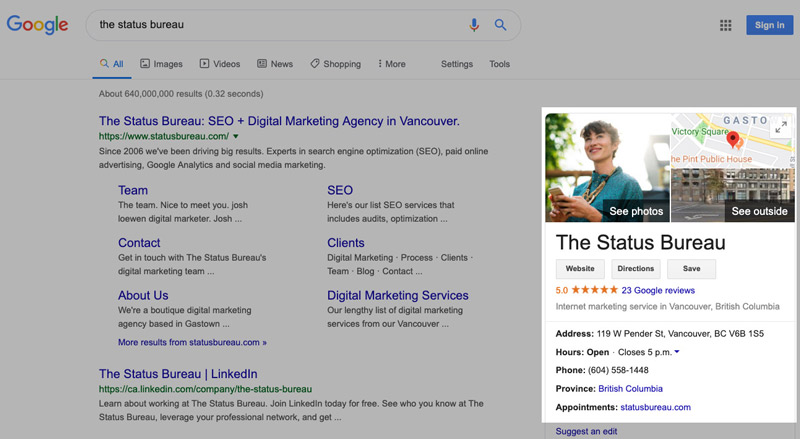
A Google Business Listing is the photos, reviews, and information in the Maps or right hand column of the Google results.
Google Business Listings are crucial to SEO because they inform Google that your location is good, open, and local. Google’s fear is providing their users with poor results which is why they have information relevant to the user.
In working in local SEO for a many years, we see this as probably the #1 factor in local rankings. Proximity, after all, is the #1 factor for local SEO. If a healthcare organization can fill this information, keep it updated, and get positive reviews, you’re off to a good start.
Here’s the top 5 things we recommend optimizing first on your Google Business Listing.
Google scans the web to understand that this organization has other pages online. The way Google will connect these mentions is from their name, address and phone number. Google will cross reference listings from sites such as Facebook, Yelp, Twitter, Healthgrades, and other important sites.
The only word of advice is to ensure NAP is in perfect, working order. The information has to match across every site or Google will lose confidence. There may be hurdles, such as a clinic having a centralized 1-800 phone number for every location.
The best practice is to have a local area code and ensure the address and map placement are accurate.
This is a bit of a cheat, but if the search query is in the business name field, it really helps. An example of that is the business name of Best Seattle Dentists. The fact that the business has the words “best seattle dentists” in the name is an extremely positive thing. It will have a much stronger chance of ranking on Google than a company named Babe Ruth’s Tooth Truth.
Keeping your days and hours accurate is a huge factor. We have seen this first hand for local organizations. If the Google Business Listing goes unchecked for months, Google loses trust in the listing and may not rank it as highly as those businesses that constantly check and update their holiday hours.
Monitoring reviews is a must, but responding to them is a really good move. It has become a best practice because it explains that the business is active and cares about their customers and patients. Google will also scan the response language to understand more about the business so drop a few keywords in there if possible.
Additional Google My Business Items to spend time on:
On your website, you need information. Information that is relevant to your audience, and information that can help them make sense of what they’re reading online. Medical information on the internet can be misleading, false, and downright worrying. The job of a healthcare digital marketer is to provide that information and optimize it so it’s you they’re getting it from.
The first thing to do is provide your users with the services you offer. If you’re a chiropractic clinic, it’s important to list whether you offer:
This seems straightforward, but some practices seem to go light on or are somehow missing this type of content. It’s important to fully describe this information. The next step is services optimization. Ensure there is a page for each page and keyword for that service. If all of the services you offer are on a single page, there’s little hope of the page ranking for every one of the services.
People often google the problem they’re having prior to visiting a healthcare provider.
For example, Americans google “plantar fasciitis” 450,000 per month, and “podiatrist” 201,000 times per month. It’s easy to see why you’d want to rank for not only podiatrist queries. Attracting searches for these terms means developing enough of the content so that Google will take that page seriously.
It’s true that with condition searches you’ll be going up against Mayo Clinic and WebMD, but we’ve had a lot of luck in areas where they are lacking.
There are 3.5 billion social network accounts in the world. Suffice to say, social networks reach a lot of people and there is a ton of healthcare information on them. Healthcare organizations can use social media to not only promote services, but they can use it to combat the surge of misinformation.
In 2018, Facebook purged dozens of misleading health sites in an attempt to slow down misleading,phony health information. The Facebook account People’s Awakening had 3.6 million followers, which lends credence to the fact that healthcare providers need to spend more time on social media correcting public information. It’s not only the right thing to do, it’s positive for the brand.
The American Medical Association’s call to speak out against false healthcare claims is a strong and well thought out piece on the freedom of speech and other factors regarding bad information on the internet. The root of it is that this information poses a risk to the public. The Centres for Disease Control and Prevention reported there were 981 cases of measles in the United States in the first half of 2019.
It is a great time for healthcare providers to stand out and become part of the conversation.
Increasing bookings for a clinic or service is the end goal for many organizations. The strategy is often focused around this metric for good reason – it’s where the dollars and cents come into play.
Increasing bookings can be broken into a pretty simple path: measuring traffic sources, on-page behaviour, phone calls and mobile performance.
Our favourite place to start in Google Analytics is in:
Acquisition > All Traffic > Source Medium
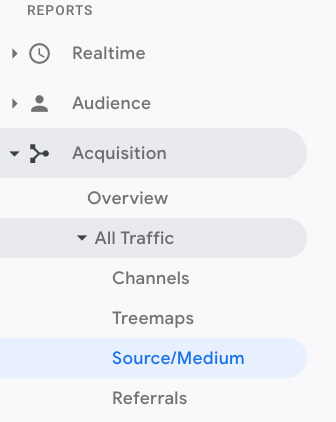
This is where you can begin understanding your performance per traffic source. A common mistake is to only look at a global performance metrics, so by checking out Source/Medium we’re one layer deeper.
One more setting and we’re all set. First we need to only track the metrics of those living in the city / state or province / country that our locations exist in. Below you’ll see I’ve set a New Segment so that we can only see visitors from the United States.
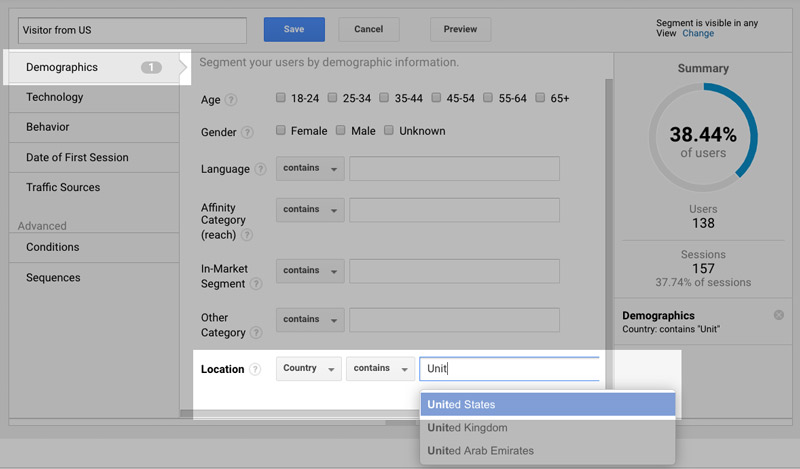
Without doing this, there may be some heavy traffic from a country of people that will not make an appointment. India is home to 1.3 billion people and that population can skew data.
Key stats to examine for performance:
Phone calls are important to a healthcare marketer, and tracking them is as well. Healthcare providers rely on phone calls for a large piece of their early communication because of the nature of the questions both parties need to ask. There may be urgency and severity that either party may not want to leave to email.
Tracking phone calls in your Google Analytics can be done a few different ways. A few ways to track phone calls are with:
Many in the healthcare industry can use Google ads with little worry. Others will have to be very cautious about their expectations. There are many restrictions and they vary per country. Sometimes the only way to truly know if you’re in the clear is to try advertising and see if there are any issues. I have heard of some accounts completely get shut down, and have seen a lot of “limited approvals”. There’s not always an extremely clear or correct reason for Google’s action, but the company is doing their best to try and adhere to local laws and keep malicious behaviour off the internet.
The Healthcare and Medicines page is definitely worthwith a review. It’s where they tackle the task of what advertisers they will allow on their network. For online pharmacies there is an application process.
On Google’s Legal Requirements page they have listed country-specific rules per country. Here’s a few interesting blocks on advertising per country.
United States:
France:
Hong Kong:
Bangladesh:
Italy:
Mexico:
Russia:
Clinics and other medical facilities understand the importance of local. The closer the patient works and lives to you the more likely they’ll book with you. With that in mind, it’s easy to recommend targeted display (banner) advertising because of its geotargeting abilities. It’s easy enough to set a targeted range on a display campaign around the facility.
As with the search ads, display has a lot of restrictions. The Health in Personalized Advertising section on Google’s Personalized Advertising page has a long list of things to be aware of.
And no remarketing with healthcare. There’s a pretty strict policy on retargeting those that have been on a healthcare site and shown ads related to those services.
We are a digital marketing agency for Healthcare, amongst other areas. We were inspired to write this as we have taken on dozens of projects in healthcare and medical SEO, and find many people asking the same questions. This is our repository to hopefully guide Healthcare marketers into the right decisions and strategies.
The original version of this page was published at: https://www.statusbureau.com/post/healthcare-digital-marketing-complete-guide
Since 2006. We're a boutique digital marketing company in Vancouver specializing in Healthcare SEO/SEM, PPC, and Analytics. We hand craft online marketing campaigns that build growth into organizat... Read more
The number of people googling for health professionals is only getting bigger. Virtual care and telemedicine has created a demand for connecting those needing care and offering it. ...read more
First impressions matter, and Google is often a first touchpoint.Customers use Google to look for products, services, brands, or even people. Eventually, they will run into a search ...read more